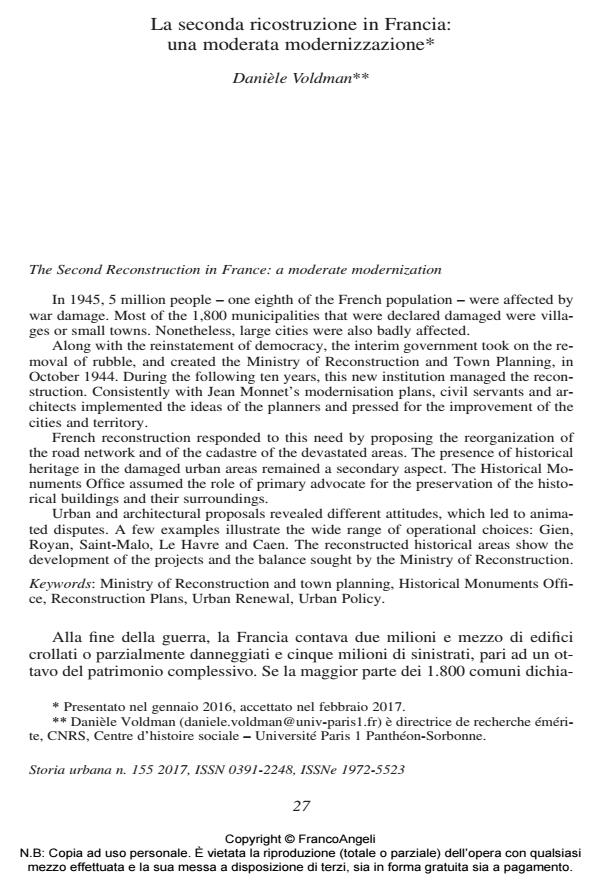La seconda ricostruzione in Francia: una moderata modernizzazione
Titolo Rivista STORIA URBANA
Autori/Curatori Danièle Voldman
Anno di pubblicazione 2017 Fascicolo 2017/155
Lingua Italiano Numero pagine 16 P. 27-42 Dimensione file 613 KB
DOI 10.3280/SU2017-155002
Il DOI è il codice a barre della proprietà intellettuale: per saperne di più
clicca qui
Qui sotto puoi vedere in anteprima la prima pagina di questo articolo.
Se questo articolo ti interessa, lo puoi acquistare (e scaricare in formato pdf) seguendo le facili indicazioni per acquistare il download credit. Acquista Download Credits per scaricare questo Articolo in formato PDF

FrancoAngeli è membro della Publishers International Linking Association, Inc (PILA)associazione indipendente e non profit per facilitare (attraverso i servizi tecnologici implementati da CrossRef.org) l’accesso degli studiosi ai contenuti digitali nelle pubblicazioni professionali e scientifiche
In 1945, 5 million people - one eighth of the French population - were affected by war damage. Most of the 1,800 municipalities that were declared damaged were villages or small towns. Nonetheless, large cities were also badly affected. Along with the reinstatement of democracy, the interim government took on the removal of rubble, and created the Ministry of Reconstruction and Town Planning, in October 1944. During the following ten years, this new institution managed the reconstruction. Consistently with Jean Monnet’s modernisation plans, civil servants and architects implemented the ideas of the planners and pressed for the improvement of the cities and territory. French reconstruction responded to this need by proposing the reorganization of the road network and of the cadastre of the devastated areas. The presence of historical heritage in the damaged urban areas remained a secondary aspect. The Historical Monuments Office assumed the role of primary advocate for the preservation of the historical buildings and their surroundings. Urban and architectural proposals revealed different attitudes, which led to animated disputes. A few examples illustrate the wide range of operational choices: Gien, Royan, Saint-Malo, Le Havre and Caen. The reconstructed historical areas show the development of the projects and the balance sought by the Ministry of Reconstruction.
Parole chiave:Ministry of Reconstruction and town planning, Historical Monuments Office, Reconstruction Plans, Urban Renewal, Urban Policy.
- Recent Articles on French History Jean-Pierre Hérubel, in French Historical Studies /2019 pp.154
DOI: 10.1215/00161071-7205281
Danièle Voldman, La seconda ricostruzione in Francia: una moderata modernizzazione in "STORIA URBANA " 155/2017, pp 27-42, DOI: 10.3280/SU2017-155002